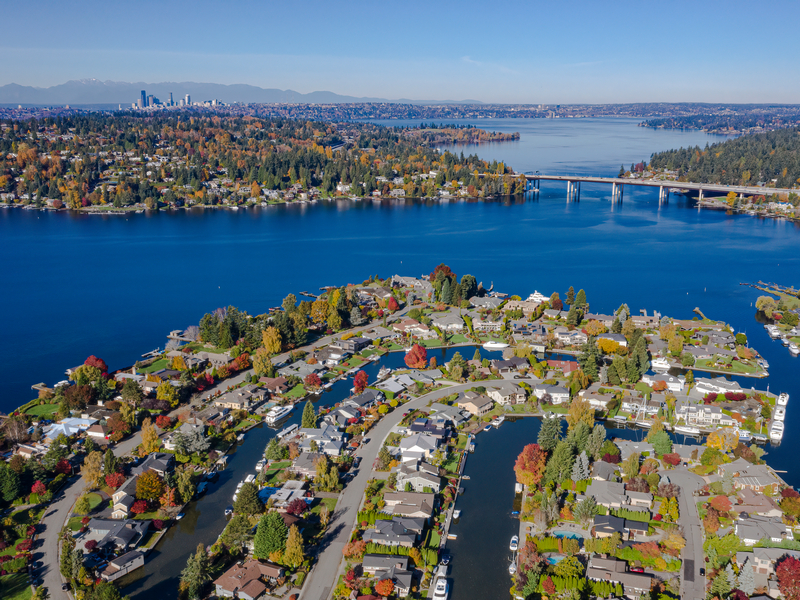
Welcome to Bellevue
You found the right website if you are searching for homes for sale in Bellevue, WA. Our website has EVERY Bellevue home for sale in Washington listed with Northwest MLS (NWMLS).
Bellevue is a city in the Eastside region of King County, Washington, United States, located across Lake Washington from Seattle. It is the third-largest city in the Seattle metropolitan area and has variously been characterized as an edge city, a suburb, boomburb, or satellite city. Its population was 122,363 at the 2010 census and 151,854 in the 2020 census. The city’s name is derived from the French term belle vue (“beautiful view”).
The Duwamish, whose main settlements were located in present-day Renton and Seattle, maintained a small outpost settlement called Satskal (SAH-tsah-kahl) along the Mercer Slough, south of present-day downtown Bellevue. It was from this village that an attack on the settlers of Elliott Bay was staged. The Duwamish also had a village near Factoria called ‘pah-pah-DEEL’.
Bellevue was first settled by European Americans in 1869 by William Meydenbauer and Aaron Mercer, who claimed homestead tracts several miles apart. Both moved away within a few years, and permanent residents did not arrive until 1879. By 1882, a community, consisting mostly of logging homesteaders, had established itself. Once the land had been logged, it was gradually cleared, largely by Japanese immigrant labor in the early 20th century, to support small-scale farming on leased land plots.
By the early part of the 20th century, Bellevue had acquired a reputation as a weekend getaway destination for Seattle residents, who would arrive by ferry at Meydenbauer Bay and spend the day at nearby Wildwood Park. After the ferry landing was moved to Medina, however, tourism to Bellevue waned. To counter this decline, the Bellevue Strawberry Festival was conceived of in 1925, and by the 1930s it had grown to attract as many as 15,000 visitors. At the time, Bellevue was still a small town with around 2,000 residents.
Prior to the opening of the Lake Washington Floating Bridge in 1940, Bellevue was mostly rural farmland area with little development. Although it was small, developers were pushing to change that; in the 1920s, James S. Ditty predicted that it would become a city with a population of 200,000. He envisioned plans that included the bridging of Lake Washington and an area filled with golf courses and airports. His map with these visions was published in 1928. Once the Murrow Memorial Bridge opened, access from Seattle improved, and the area began to evolve into a bedroom community.
In 1942, the Bellevue Strawberry Festival was cancelled. The primary reason was that some 90 percent of the agricultural workforce in the area was of Japanese ancestry, and all of these farmers and their families had been forcibly interned in camps following the start of World War II. The fair would not be revived for another 45 years. Following the expulsion of the ethnic Japanese farming community, a large quantity of farmland became available for development. This made way for the initial development of the Bellevue downtown area.
Bellevue incorporated as a third-class city on the March 31, 1953. Following the 1963 opening of a second bridge across the lake, the Evergreen Point Floating Bridge, the city began to grow more rapidly. The Crossroads community was annexed in 1964. Lake Hills was annexed in 1969. By the 1970 census, Bellevue had become the fourth most populous city in the state of Washington, behind only Seattle, Spokane, and Tacoma.
Bellevue remains one of the largest cities in the state, with several high-rise structures in its core and a burgeoning business community. The city experienced a building boom during the mid-2000s, with the building of developments such as Lincoln Square and the Bravern.
Bellevue Square is located in downtown Bellevue and is now one of the largest shopping centers in the region. Opened in 1946, the mall has undergone several significant phases of expansion since the 1980s.
The city’s plans include the Bel-Red Corridor Project, a large-scale planning effort to encourage the redevelopment of the large Bel-Red section of the city bordering the adjacent town of Redmond which is a major employment area in the city. Patterned after the redevelopment of the downtown core, plans include superblock mixed-use projects similar to Lincoln Square, premised on private construction and the development of infrastructure such as the extension of Link light rail to the Eastside.
Bellevue lies between Lake Washington to the west and the smaller Lake Sammamish to the east. Much of Bellevue is drained by the Kelsey Creek watershed, whose source is located in the Larsen Lake and Phantom Lake green belt and whose outlet is near where Interstate 90 meets Lake Washington’s eastern shore. The city is bisected by Interstate 405 running north–south, and the southern portion is crossed from west to east by Interstate 90. The State Route 520 freeway roughly delineates the upper reaches of Bellevue.
According to the United States Census Bureau, the city has a total area of 36.47 square miles (94.46 km2), of which 31.97 square miles (82.80 km2) is land and 4.50 square miles (11.65 km2) is water.
The city’s name is derived from a French term for “beautiful view”. Under favorable weather conditions, scenic vistas of the Olympic Mountains and Cascade Mountains can be viewed from hilltops (and strategically positioned high-rise buildings) within the incorporated city.
South of I-90, the city continues up Cougar Mountain, at the top of which is an unincorporated King County location called Hilltop. To the west of Cougar Mountain, Bellevue includes the Coal Creek, Somerset, and Factoria neighborhoods.
Bellevue is bordered by the cities of Kirkland to the north and Redmond to the northeast along the Overlake and Crossroads neighborhoods. Across the short East Channel Bridge, I-90 connects Bellevue to Mercer Island to the southwest. Issaquah is to the east, down I-90 at the south end of Lake Sammamish. The city is bordered to the west by many affluent suburbs such as Medina, Clyde Hill, Hunts Point and Yarrow Point. The south end of Bellevue is bordered by the city of Renton, and to the southeast, the relatively recently incorporated city of Newcastle.
Bellevue is the main Eastside hub for both the local transit authority, King County Metro, and Sound Transit, the regional transit system. The Bellevue Transit Center, which serves both Metro and Sound buses, is located in the heart of the downtown business district and is connected to Interstate 405 by NE 6th St. and a direct-access Texas T HOV ramp. Local buses run into Kirkland, Redmond, Issaquah, Renton, and the University District; regional buses go to Bothell, Lynnwood, Everett, Seattle, Renton, Kent and Auburn, among other cities.
The Line 2 of Sound Transit’s Link light rail system is planned to run from Seattle through Mercer Island and Bellevue before ending in Redmond. It was approved by voters on November 4, 2008, as part of the Sound Transit 2 ballot measure. It began construction in 2015 and is scheduled to begin service in 2023.
The Bellevue City Council lobbied hard for Sound Transit—the regional transit authority—to construct its light-rail line underground through Bellevue’s rapidly growing downtown. Bellevue promised to devote between $104 million to $150 million toward a potential tunnel in the form of cash, services, free access to rights-of-way and one-time tax revenues that result from the East Link project. In November 2011, the council signed an agreement with Sound Transit. Tunnel construction started in early 2016 while the remainder of downtown Bellevue construction began in mid-2017. Former Bellevue City Council member Claudia Balducci is a member of the Sound Transit board of directors.
The City of Bellevue has undertaken an extensive “Bel-Red Area Transformation” process which seeks to plan some 900 acres (3.6 km2) in the Spring District in the city’s northern portion, all of which is premised on the extension of light rail to the Eastside under Sound Transit 2. The top-down and highly integrated land use and transportation planning is similar to earlier planning for the Downtown.
Bellevue was also served by a railroad, a Burlington Northern branch line known as the Woodinville Subdivision, which included the historic Wilburton Trestle. The line is now disused, though part of the track bed at Wilburton Station will be reused by Sound Transit’s light-rail construction. Construction of Eastrail, a rail trail on the abandoned Woodinville Subdivision right of way through Bellevue, is planned to be completed in 2023. Some sections of the railroad in Bellevue were demolished in 2008 to make way for the expansion of I-405 and will require the construction of additional structures to supplement the existing right of way.
The city once had an operating airfield named Bellevue Airfield.
The city is served by the Bellevue School District. There are four main public high schools – Bellevue High School, Interlake High School, Newport High School, and Sammamish High School – as well as two choice lottery high schools, International School and Big Picture School. Newsweek’s 2015 ranking of U.S. public high schools placed Interlake at #359 and Newport at #391, with both schools noted for equitably helping low-income students meet average scores on standardized tests. Portions of Bellevue also lie within the boundaries of Lake Washington School District, Renton School District and Issaquah School District. At the higher education level the city is home to Bellevue College, part of the Washington Community and Technical Colleges system.
Bellevue is home to Open Window School, an independent school serving gifted students from kindergarten through eighth grade. The Jewish Day School of Metropolitan Seattle is located in Bellevue, serving students from Pre-Kindergarten to Grade 8. At the elementary level, Bellevue is home to several Montessori schools, the Eastside’s only Waldorf education at Three Cedars School, as well as Bellevue Christian School. The Seattle Japanese School, a Japanese weekend supplementary school, holds its classes in Bellevue.
Bellevue is an economic hub of the Seattle region’s Eastside and home to the headquarters of various sizes, including the U.S. operations for many international firms. Since 2005, the city has become a hub for software engineering and other technology development centers. These include Expedia, PACCAR Inc, T-Mobile US, Eddie Bauer, SAP Concur, and Symetra. Bellevue hosts a number of satellite offices for large technology companies such as eBay, Oracle, Salesforce, Google, and Microsoft; Microsoft was at one point headquartered in Bellevue but has since moved to the neighboring community of Redmond, Washington. Celebrated video game companies Valve, Bungie, Sucker Punch Productions, and The Pokémon Company are also based here.
In 2019, Amazon and Facebook announced plans to open large engineering centers in Bellevue with plans to add several thousand employees. In 2018, Google also opened a major engineering facility in downtown Bellevue. As of 2020, there are several high-rise office buildings in Downtown Bellevue that are under construction or in active planning and design phases, including Bellevue 600, part of a major Amazon campus. Several high-rise residential buildings are also planned in downtown, spurred in part by future light rail service, on former retail and low-rise commercial lots.
The city has numerous thriving commercial districts, with four major shopping centers: Bellevue Square in the downtown area, Factoria Mall to the south, Crossroads Mall to the east, and the Overlake Shopping District in the north.
Recurring cultural events
Bellevue is the site of the popular annual Bellevue Arts and Crafts Fair (originally Pacific Northwest Arts and Crafts Fair), held since 1947 the last weekend in July. The biennial Bellevue Sculpture Exhibition draws thousands of visitors to the Downtown Park to view up to 46 three-dimensional artworks from artists around the country. In celebration of its strawberry farming history, Bellevue holds an annual Strawberry Festival on the fourth weekend in June at Crossroads Park. The festival initially began in 1925, and continued to 1942 when many Bellevue’s strawberry farmers were incarcerated as part of the Japanese Internment. In 1987 the festival was resumed as a one evening event, and in 2003 it was expanded back to a multi-day festival.
Places of interest
The Bellevue Arts Museum first opened in 1975, then moved to Bellevue Square in 1983. In 2001, the museum moved into its own building, designed by Steven Holl. The museum subsequently ran into financial difficulties and was closed to the public in 2003. After a lengthy fundraising campaign, a remodel, and a new mission to become a national center for the fine art of craft and design, the museum reopened on June 18, 2005 with an exhibition of teapots. The Rosalie Whyel Museum of Doll Art – now closed – contained one of the largest doll collections in the world—more than a thousand dolls—displayed on two floors of a Victorian-style building, which is now the site of the KidsQuest Children’s Museum. Near Interstate 405 is Meydenbauer Center, a convention center that brings corporate meetings and charity events to the downtown area. Meydenbauer also includes a 410-seat theater which attracts operas, ballets, and orchestral performances.
The city government has planned to build a performing arts center, tentatively named the Tateuchi Center (named for philanthropist Ina Tateuchi), since the 1980s. It would include a 2,000-seat concert hall, offices, and creative spaces at a site in Downtown Bellevue. The $200 million project is partially funded with private donations and grants from the city and county governments.
Sports and recreation
Since the 1970s, the city has taken an active role in ensuring that its commercial development does not overwhelm its natural land and water resources. Today, the Bellevue Parks and Community Services Department manages more than 2,500 acres (10 km2) of parks and open spaces, including the Downtown Park and the Bellevue Botanical Garden, as well as several playgrounds, beach parks, and trails. More than 5,500 Bellevue residents participate in volunteer activities through this department annually.
Bellevue was home to the American Basketball Association team, the Bellevue Blackhawks. The Blackhawks in 2005, despite being ranked 13th in the league, made it to the championship game in front of 15,000 fans in Little Rock, Arkansas. The team has been inactive since 2006.





